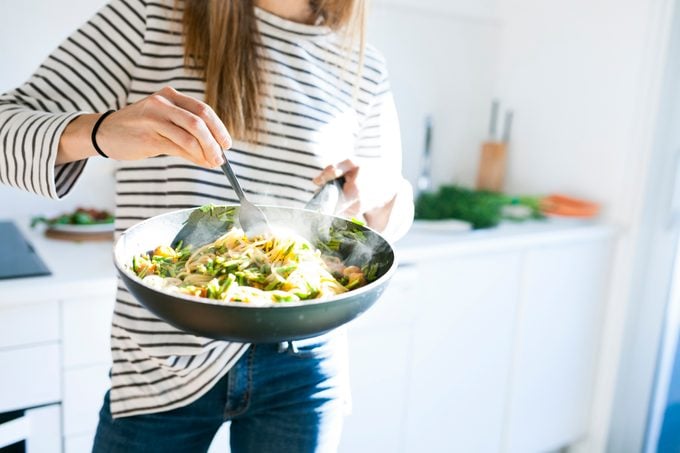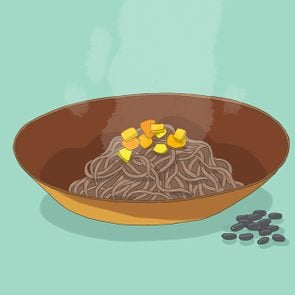The Best Healthy Spaghetti Recipe This Nutritionist Makes on Repeat
Updated: Mar. 28, 2022
Is pasta healthy? And what about our favorite noodle—spaghetti? A registered dietitian sets the facts straight and shares her go-to healthy spaghetti recipe that's rich in protein, fiber, and good-for-you fats.
Pasta nutrition
A healthy spaghetti recipe coming from a dietitian is not an oxymoron. I’m a registered dietitian, and I fully approve of spaghetti (read my article about why pasta is healthy for more details) and all kinds of pasta varieties. I’ll tell you why.
Let’s get into the nutrition of pasta first. Many people are fearful of pasta because of the high carbohydrate content. And trust me, I get it. The health industry is currently in a phase of demonizing carbs and making them outcasts, claiming they cause all of our problems.
According to a research review in the journal Starch, when we eat carbohydrates, our body breaks those carbs down into glucose. This glucose, or sugar, is the energy source the body prefers. It fuels everything we do—from getting out of bed and walking the dog, to our thought processes and workouts.
That’s right—I believe carbs are not only good for you, but they’re necessary. The catch is that people must eat carbs in appropriate portions and with other nutrients. If we only eat carbs on their own, in large amounts, that’s when they become unhealthy. That can lead to high blood sugar, potential insulin resistance, and maybe even weight gain.
How to prepare your favorite type of pasta in a healthy way
So, let’s get back to pasta. When I mentioned that we have to be conscious of what we pair carbs with, that certainly goes for pasta. Since pasta is mainly carbohydrates, we want to make sure we pair it with other macronutrients (protein and fat), and fiber. This will ensure slow digestion, and the biggest nutritional bang for your buck.
Pack your pasta dish with protein
First, let’s talk about protein. Protein is one of the primary building blocks of muscle, bone, and cartilage. It also plays a key role in hormone regulation. Finally, it’s super filling. When we eat protein, we break it into smaller peptide chains that block mu-opioid receptors (MORs)—little receptors that either tell the brain to keep eating, or to stop. When MORs are blocked, we experience the feeling of fullness, according to research published in eLife.
Adding things like ground chicken, turkey, or lean beef are all excellent options to add protein to pasta. You can also add shrimp, cod, salmon, tuna, or tofu to bump up the protein content.
If you really want to be an overachiever, go for bean-based pastas. These include pastas made from chickpeas, lentils, or black beans. They contain about double the protein as regular pasta! Combining a bean-based based and a lean protein will make for a super-satiating meal.
(Here are more of the healthiest pasta to try.)
Add healthy fats
We can’t forget about healthy fats. Fats are essential to the diet. They provide lots of energy for cell growth and everyday functions, and nutrients that allow us to absorb certain essential vitamins—ever heard of fat-soluble vitamins? Well, these are vitamins A, D, E, and K, and they are vital for a multitude of bodily functions. But, they need fat for the body to absorb them properly.
So, how can we add healthy fats to pasta? This part is all about the sauce. If you’re going with marinara, sauté your garlic in some extra virgin olive oil. If you’re going with pesto, blend your pesto with olive oil and avocado—not only will this add healthy fats, it will add amazing creaminess. If you’re craving pasta on the creamier side, blend some cashews and water until a thick cream forms, upping the healthy fat content.
Include fiber-rich foods
Fiber is so critical for several bodily functions. For starters, it helps keeps us regular. See, we actually are unable to digest fiber. So, it passes through our system, collecting waste and excreting it via our stool. Further, fiber serves to keep cholesterol levels low. In particular, soluble fiber binds to cholesterol in the body, and prepares it for leaving the body.
We add fiber to pasta with the help of one magical word—veggies. (Veggies are always the answer.) A great rule of thumb is to always include veggies at dinner, no matter what. Adding things like mushrooms, peppers, onions, or zucchini to pasta dishes adds bulk and lots of fiber. Even adding just one cup of spinach (which we all know wilts down to basically nothing) adds about four grams of fiber.
I suggest sticking to non-starchy vegetables with pasta. Since the pasta has a high content of carbs, no need to add more with starchy veggies such as peas or potatoes. Instead, opt for asparagus, green beans, Brussels sprouts, cauliflower, broccoli, or eggplant.

Yes, you should keep an eye on your portions
Before we get into my favorite spaghetti recipe, we have to talk about portions. You can do all the things I just mentioned—include protein, fat, and fiber—but if you don’t use appropriate portions, that healthy pasta dish can quickly turn into a high-carb, blood sugar-spiking ordeal. You want to stick to two ounces of dry pasta per serving. This will make about three-quarters of a cup to a full cup of cooked pasta.
Now I know what you’re thinking: Who’s that going to feed? It certainly doesn’t resemble the huge platter-size portions we’re used to seeing at restaurants. But that is why we want to make sure to include protein, healthy fats, and fiber. Including those nutrients will ensure that you’re making a balanced, well-rounded, and filling meal. So you won’t actually feel like you’re missing out on anything.
The mistake many people make when it comes to pasta is that they make it the star of the show. The portion of the pasta itself is much too big, and portions of protein and fiber are much too small. I love to use the plate method as a rule of thumb: Fill half your plate with non-starchy vegetables, a quarter of your plate with lean protein, and a quarter of your plate with a carbohydrate or starchy food. This will help keep your pasta portion in check.
(Here’s the other healthy pasta recipe this nutritionist loves.)
Shrimp and veggie pesto spaghetti toss
Alright, onto the exciting part—my favorite healthy spaghetti recipe. Remember when I talked about the importance of protein, healthy fats, and fiber? Well, this recipe has all three, plus our beloved spaghetti. Pro tip: Make extra. The leftovers are even better.
Ingredients:
(Serves four)
For the pesto:
1 bunch basil (about 1 cup basil leaves)
2 cups baby spinach
1/3 cup olive oil
1 avocado
2 cloves garlic
Zest and juice of one lemon
2 tablespoons pine nuts (can use any nut you prefer)
2 tablespoons Parmigiano Reggiano cheese
Pinch of salt & pepper
For the pasta:
8 oz spaghetti (about 2/3 of a box; can use regular or whole wheat)
16 oz shrimp (about 5 shrimp per person, depending on size)
1 medium zucchini, chopped
1 medium yellow squash, chopped
1 cup mushrooms, chopped
1 small red onion, chopped
1 tablespoon olive oil
Pinch of salt and pepper
Instructions
Prepare the pesto. Combine all ingredients except for olive oil in a food processor. Pulse until all ingredients are blended to uniform size—about 10 times. Then, while food processor is on low, slowly stream in olive oil until pesto comes together. If needed, add warm water to thin, 1 tablespoon at a time.
Bring a large pot of water to a boil. Add the spaghetti, and cook according to package instructions. Before draining, set aside 1 cup of the hot, starchy cooking water.
In a large saucepan, add olive oil and chopped vegetables. Sauté until veggies are tender, about five minutes. Once veggies are cooked, add shrimp to the pan. Season with salt and pepper. Cook shrimp until light pink, about two minutes per side.
When shrimp are fully cooked, add the spaghetti and pesto. Mix thoroughly. If mixture is too thick, add starchy cooking water, 1/4 cup at a time, until desired consistency is reached. Enjoy!
Bottom line—don’t fear spaghetti or pasta in general. There’s nothing to fear, and there’s no reason to avoid it. Just be smart about what you pair it with and watch your portion sizes. This shrimp and veggie pesto pasta toss is the perfect recipe to try out.






















